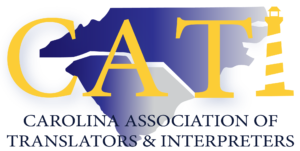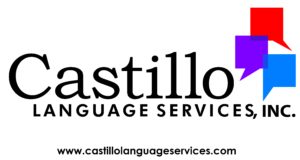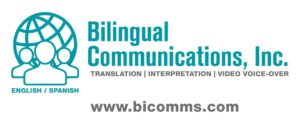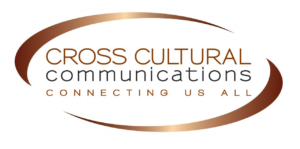CATI will host our Annual Conference on
Saturday, November 13, 2021.
This conference will be held virtually again this year.
KEYNOTE:
Is the Future of Human Translation Really as Bleak as it Feels Sometimes? Strategies to Future-Proof Your Business
Presented by Jost Zetzsche

We live in extraordinary times. Between an unpredictable economy and developments in technologies that are based on artificial intelligence, it’s not surprising that many translators wonder what the immediate and mid-term future holds for our profession.
In this talk, Jost will take a look at why he thinks the translation profession has a promising future, what that future will look like, and what you can do to equip yourself to be a part of it.
Speaker Bio: Jost Zetzsche is a translation industry and translation technology consultant, an author on various aspects of translation, and an ATA-certified English-to-German technical translator. 1999 Jost co-founded International Writers’ Group, LLC, on the Oregon coast. Originally from Hamburg, Germany, he earned a Ph.D. in the field of Chinese translation history and linguistics at the University of Hamburg. Since 2016 he has been contracting with United Bible Societies to help create and curate the Translation Insights and Perspectives (TIPs) tool. In 2018 he was awarded with an honorary membership to the ATA. In 2021 he published “Characters with Character: 50 Ways to Rekindle Your Love Affair with Language.”
Learning Objectives:
- Understanding the current state of the translation industry
- Adjusting how to adjust ideas of specialization vs. diversification
- Adjusting ideas on translation technology
————————————————————————————————————————————————————————-
Gold Conference Sponsor:
Silver Conference Sponsors:
CATI is looking for Sponsors for this event.
Your sponsorship helps to make this conference possible. You are supporting the T/I profession by supporting CATI and allowing us to offer educational programming.
Gold Sponsors-
- Logo in program
- Logo on website with link to your website
- 2 minutes to present during the general meeting
- 2 Social Media posts
- 1 Entry to the conference
Silver Sponsors-
- Logo in program
- Logo on website with link to your website
- 1 Entry to the conference
Click here to sign up to be a sponsor.
————————————————————————————————————————————————————————-
CONFERENCE SCHEDULE:
9:00-10:15 Keynote Session – Is the Future of Human Translation Really as Bleak as it Feels Sometimes? Strategies to Future-Proof Your Business by Jost Zetzsche (1-ATA)
10:15 – 11:00 Coffee Break – Breakout Rooms
11:00-12:00 First Breakout Session
1A – Transgender Naming Labels in the Press: Linguistic Choices of Inclusive Language for English-Spanish Translators and Interpreters by Dr. Javier García León and Dr. Mónica Rodriguez-Castro – T/I (1-ATA)
1B – Remote Simultaneous Interpreting in the Medical Setting by Johanna Parker – I (1-ATA)
1C – Best Practices for Remote Team Interpreting by Ludmila Baker and Ernesto Niño-Murcia – I (1-ATA)
Lunch 12:00-1:30
1:30-2:30 General Meeting with Board of Directors
2:30-3:30 Second Breakout Session
2A – The Translation School of Witchcraft and Wizardry: The Wondrous World of Bible Translation and the Tool That Unlocks It by Jost Zetzsche – T (1-ATA)
2B – Healthcare Interpreting: Clinical Instruction and Evaluation by DeOnna Lavette Reliford – I (1-ATA)
2C – Nonverbal Cues that Impact Source- Language Meaning by Janis Palma – I (1-ATA)
3:00-3:45 Coffee Break
3:45-4:45 Third Breakout Session
3A – An Energetic Model for Translating Camfranglais Literature by Peter Wuteh Vakunta – T (1-ATA)
3B – Speaking While They Speak: Tips to Enhance Your Simultaneous Interpreting Skills by Gabriela Espinoza Siebach – I (1-ATA)
3C – Emoticons, Emojis, Smileys and Stickers, Oh My! What is an Interpreter to do? by Holly Silvestri – I (1-ATA)
ATA, CCHI, IMIA and NC Courts CEU’s pending.
————————————————————————————————————————————————————————-
SESSION DESCRIPTION:
1A – Transgender Naming Labels in the Press: Linguistic Choices of Inclusive Language for English-Spanish Translators and Interpreters by Dr. Javier García León and Dr. Mónica Rodríguez-Castro
Over the last two decades, both Latin American and North American newspapers, talk shows, television news, and films have been increasingly representing transness. This higher coverage in the media, however, juxtaposes with the fact that trans people continue to face high rates of violence in several countries. As a result, the relationship between trans visibility and vulnerability is complex and raises a series of questions: How does media depict trans individuals? And What labels are generally used to name trans people? Transgender representation in press authored in English has been investigated. Nevertheless, this type of representations has been overlooked in more traditional media platforms such as the press in English (Zottola 2018) and in the quality press in Spanish (García León 2021). Using a corpusbased study, this presentation will compare the naming labels used to portray transgender identities in the press authored in Spanish and in English.
In this session, we will present the most commonly used labels in English and Spanish to advocate for more inclusive linguistic choices when referring to underrepresented communities. We will also provide samples of more negative discriminatory representations that can be avoided in favor of a more positive target rendering. We will conclude this presentation by sharing some strategies that translators (English – Spanish) can implement when translating texts that address trans and non-binary individuals.
Learning Objectives:
- Describe trans representations in the press (English and Spanish);
- Compare commonly use trans labels in English and Spanish discourses, and
- Advocate for inclusive language in trans representations in both target cultures.
1B. Remote Simultaneous Interpreting in the Medical Setting
The COVID-19 pandemic rocked the interpretation industry as conferences, meetings, and appointments moved online overnight and interpreters pivoted to remote technologies. The medical interpreting community was uniquely positioned to adapt to this change, because telephonic and video remote interpretation have been common in the medical setting for many years. However, the existing remote interpreting infrastructure was designed to provide consecutive interpreting, given that most medical interpretation is done consecutively. Simultaneous interpreting does take place in the medical setting, however, and thus Remote Simultaneous Interpreting (RSI) also has a place in this setting. In this session, the presenter will discuss how her team worked in collaboration with Stanford Health Care IT to implement viable RSI solutions. She will cover RSI best practices, the challenges of performing RSI in a medical setting, and the positive effects
- Develop the ability to provide clinical instruction and evaluation of future entry-level healthcare interpreters
- Identify the guidelines and procedures for healthcare interpreting in clinical settings
- Describe how to evaluate healthcare interpreting students in three domains of learning: cognitive, psychomotor, and affective
1C. Best practices for remote team interpreting by Ludmila Baker and Ernesto Niño-Murcia
During this webinar, you will learn how to work with a partner when interpreting remotely, how to prepare materials, how to execute seamless handovers and to set up a monitor device to communicate and hear each other during an assignment. We will discuss tried and tested approaches to educate clients on how to work with interpreters, carry out sound checks and guide participants on how to use the Zoom interpreting function. We will have a short demo and cover some basics about Zoom’s interpreting function.
Learning objectives:
- To learn how to create a virtual “interpreter booth” using a monitor device.
- To develop a professional set of solutions and strategies for each client (how to deliver instructions to participants, how to assist during a sound check)
- To agree on team strategies and rules (What does the passive interpreter do/handle while the active interpreter is working? Do you have a plan for emergency situations, like the loss of connection?)
2A. The Translation School of Witchcraft and Wizardry: The Wondrous World of Bible Translation and the Tool That Unlocks It by Jost Zetzsche
What if we could take a guided tour of the process and results of a text’s translation into several thousand languages? How would that change our perception of the text and the nature of translation? Jost will examine how this is possible via the Translation Insights and Perspectives tool. He’ll suggest how we can rediscover the joy and the power of our profession by immersing ourselves in its readily available content.
Learning Objectives:
- (Re-) Embracing the joys and the importance of language and translation
- Understanding the importance of language preservation
- Learning about a new tool to learn about translation techniques and strategies
2B. Healthcare Interpreting: Clinical Instruction and Evaluation by DeOnna Lavette Reliford
In this presentation, attendees will develop the ability to provide clinical instruction and evaluation of students who are in the process of becoming entry-level healthcare interpreters. Attendees will receive a suggested handbook of guidelines and procedures for healthcare interpreting in clinical settings, which covers various policies, such as physical exam requirements; variance reports; HIPAA; confidentiality; and communicable disease and infection control. Attendees will also receive a suggested clinical evaluation tool, which will help to evaluate healthcare interpreting students in three domains of learning: cognitive, psychomotor, and affective, with performance criteria that entry-level healthcare interpreters are expected to master.
Learning Objectives:
- Develop the ability to provide clinical instruction and evaluation of future entry-level healthcare interpreters
- Identify the guidelines and procedures for healthcare interpreting in clinical settings
- Describe how to evaluate healthcare interpreting students in three domains of learning: cognitive, psychomotor, and affective
2C. Nonverbal Cues that Impact Source-Language Meaning by Janis Palma
Meaning in spoken language is not limited to the words we use to convey thoughts. A tone of voice, a raised pitch, an ungrammatical pause, a deliberate lowering of volume or speed, can all contribute to the overall meaning of a spoken message. Interpreters must know how to identify these nonverbal cues and incorporate them into their renditions. Conversely, they must be mindful not to distort a target language message by incorporating the wrong nonverbal signs.
Learning Objectives: At the end of the presentation, attendees will be able to
- Distinguish how speech communities provide contextual meaning to verbal and nonverbal communications;
- Identify nonverbal and other pragmatic elements of speech, such as pitch, tone, volume, pauses, repetitions, hesitations, false starts, incomplete sentences, hedges, and how they affect the meaning of verbal utterance;
- Analyze which nonverbal and pragmatic elements of source-language speech are part of the meaning that must be conveyed in the target language and how to avoid incorporating the wrong nonverbal cues into the target language rendition.
3A. An Energetic Model for Translating Camfranglais Literature by Peter Wuteh Vakunta, Ph.D.
The distinctive feature of Camfranglais literature is authors’ recourse to linguistic hybridity as a narrative paradigm. In an attempt to convey cultural specificities, worldviews, imagination and sensibilities in a European language, fiction writers tend to resort to a third code, in our case Camfranglais, as a narrative mode. This style of writing poses daunting challenges for literary translators. Jacques Derrida reminds us in “Des Tours de Babel” (1985) of the limitations of theories of translation. All too often they treat the passing from one language to another and do not sufficiently address the possibility for languages to be implicated more than two in a text.
How is a text written in several codes to be translated? How is the effect of narrative plurality in source texts to be rendered? The dilemma is not easy to resolve for practicing translators as seen in our translation of Fonkou’s novel, Moi taximan (2001) in this article. The intent of this paper is to discuss the merits of an exegetic model conceived by this author to ease the translation of literature written in hybridized languages. This model equips translators with the tools necessary to achieve dynamic equivalence in the translation process. It is our hope that attendants at this panel would glean a couple of translation nuts and bolts that would facilitate the translation task for them.
Learning Objectives: Participants will be able to …
- Participants will familiarize themselves with Canfranglais
- Participants will familiarize themselves with Camfranglais literature.
- Participants will familiarize themselves with canons necessary for translating Camfranglais literature.
3B. Speaking While They Speak: Tips to Enhance Your Simultaneous Interpreting Skills by Gabriela Espinoza Siebach
Although the codes of ethics and standards of practice that guide and direct our practice advise us to “[disclose] skill limitations with respect to particular assignments” and to “accurately represent [our]… training and pertinent experience,” stakeholder expectations and market needs have forced many of us to attempt simultaneous interpreting using our instinct and consecutive skills to guide our practice. In this interactive presentation, participants will have an opportunity to explore the mysteries of simultaneous interpreting and learn new ways to continuously develop and enhance their skills in one of the most challenging modes of interpreting.
Learning Objectives: Participants will be able to…
- Describe the primary elements of simultaneous interpreting that distinguish this mode from other modes of interpreting;
- Identify the area in which their simultaneous interpreting technique needs the most improvement; and
- Apply one strategy to enhancing and/or developing their simultaneous interpreting skills.
3C. Emoticons, Emojis, Smileys and Stickers, Oh My! What is an Interpreter to do? By Dr. Holly Silvestri
There are 3.2 billion people who have regular internet access in the world, and studies show that 92 percent-plus of those 3.2 billion people regularly send emojis. As a result, these graphicons are also showing up more and more frequently in court as part of evidence, not to mention their appearance in medical settings given the rise of telemedicine. But the multiple meanings of emoji are not always readily grasped. So how is an interpreter supposed to deal with these graphicons?
This presentation will provide both spoken and signed language legal and medical interpreters with the reasons why these graphicons are so difficult to interpret and provide some best practices recommended by a research group of working professional interpreters in the USA.
Learning objectives:
Participants will be able to:
- Define an emoji, emoticon, smiley and sticker
- Intelligently explain to clients the difficulties involved in sight translation and translation with these graphicons
- Explain best practices in legal and medical settings where these graphicons are a factor for the interpreter or translator
Speaker Bio’s in alphabetical order by first name:
DeOnna Lavette Reliford – A graduate of Northwestern University’s prestigious Medill School of Journalism, DeOnna earned a Master of Arts in Spanish: Translating and Translation Studies from The University of North Carolina at Charlotte, completed graduate courses in applied interpreting studies and methodology of teaching interpreting at Wake Forest University, and received her Master of Public Health (Community Health concentration), as well as a Graduate Certificate in Healthcare Translation and Interpreting from East Tennessee State University. Currently, DeOnna works at Wake Forest University as a Visiting Professor of Spanish and as a part-time instructor of healthcare interpreting at Davidson-Davie Community College.
Ernest Niño-Murcia – Ernest Niño-Murcia is a state and federally certified court interpreter based in Des Moines, Iowa. Outside of court, he has interpreted for figures as Newt Gingrich, Bernie Sanders and Elizabeth Warren, among others. In 2020, he co-founded T.E.A. Language Solutions to provide remote interpreting training, consulting and technical support to interpreters and clients. He has given trainings for the National Center for State Courts, NAJIT, the University of Arizona and the U.S. Department of Justice. Additionally, Ernest is a Jeopardy! Champion, whose proudest moment was beating an attorney to the buzzer to answer “co-defendant” in the “11 letter words” category.
Gabriela Espinoza Siebach – Gabriela Siebach, Conference Interpreting Services Manager at Cesco Linguistic Services, has accumulated more than 15 years of professional experience as a linguist, interpreter, translator, trainer, coach, and mentor. She has spearheaded the development of multiple training and assessment programs throughout her career. Gabriela holds a graduate degree in Spanish translation and interpretation from the world-renowned Middlebury Institute of International Studies at Monterey. A former Board member of the National Council on Interpreting in Health Care (2019-2021), she currently leads various Council initiatives as Chair of the Policy, Education & Research Committee. Gabriela also Co-chairs the American Association of Interpreters and Translators’ Job Task Analysis Committee and is a member of the American Translators Association and ASTM.
Dr. Holly Silvestri – In addition to having significant experience in the field of secondary and university education, Dr. Silvestri has run her own LSP agency as well as freelancing for other agencies and government entities. Currently she works as Senior Coordinator for Translation, Training, and Curriculum at the National Center for Interpretation at the University of Arizona. She has also taught in their undergraduate Spanish Translation and Interpretation program. Her working languages are Spanish, French and English. She is a founding member of American Association of Interpreters and Translators in Education, an organization dedicated to the professionalization of those who interpret/translate in school-based settings.
Janis Palma – Janis Palma is an English-Spanish interpreter and translator with 40 years of experience. She became federally-certified as a judiciary interpreter in 1981, certified by NAJIT as an interpreter and translator in 2004, and was licensed in 2017 by the State of Texas as a Master Court Interpreter. Ms. Palma has worked as an independent contractor for private attorneys, government agencies, state and federal courts, and worked as a staff interpreter for the U.S. District Court in Puerto Rico for 15 years until she retired in 2017. She is currently the Chair of the NAJIT Board of Directors.
Dr. Javier García León – Javier García León (Ph.D. University of Ottawa) is an Assistant Professor of Spanish at the University of North Carolina at Charlotte and currently serving as Associate Editor for the Spanish Journal of Applied Linguistics. He teaches specialized courses on Spanish linguistics. His primary research interests include critical discourse analysis, sociolinguistics, language policies as well as media representation. His articles have appeared in Latin American Research Review, Canadian Journal of Latin American and Caribbean Studies, Boletín de Filología among other journals.
Johanna Parker – Johanna Parker is a federally and California certified court interpreter and CCHI Certified Healthcare Interpreter™ and holds an M.A. in Translation and Interpretation (Spanish <>English) from the Middlebury Institute of International Studies at Monterey (MIIS). She is Lead Interpreter for Education and Training at Stanford Health Care, a freelance conference interpreter, and a contract seminar interpreter for the U.S. Department of State. Johanna trains healthcare and court interpreters around the country and is an adjunct professor at MIIS, where she teaches medical interpreting. She is a CCHI Commissioner and recipient of the California Healthcare Interpreting Association’s Trainer of the Year award.
Jost Zetzsche – Jost Zetzsche is a translation industry and translation technology consultant, an author on various aspects of translation, and an ATA-certified English-to-German technical translator. 1999 Jost co-founded International Writers’ Group, LLC, on the Oregon coast. Originally from Hamburg, Germany, he earned a Ph.D. in the field of Chinese translation history and linguistics at the University of Hamburg. Since 2016 he has been contracting with United Bible Societies to help create and curate the Translation Insights and Perspectives (TIPs) tool. In 2018 he was awarded with an honorary membership to the ATA. In 2021 he published “Characters with Character: 50 Ways to Rekindle Your Love Affair with Language.”
Ludmila Baker – Ludmila Baker is a conference interpreter and a federally certified court interpreter based in Dallas, Texas. She grew up in Tierra del Fuego, Argentina, and has lived in the United States since 2005. She started as a staff medical interpreter for UNC Hospitals in Chapel Hill, NC, in 2007. She has lived and worked in several states, including Kentucky, Ohio, Indiana, Tennessee, Missouri, North Carolina, and Texas. In 2020, she launched FILO Language Solutions and has since then interpreted during several conferences for NGOs, The U.S. Department of Justice, The Government, and private entities. In her free time, she travels the world with her family, cooks, and keeps bees.
Dr. Mónica Rodríguez-Castro – Mónica Rodríguez-Castro (Ph.D. Kent State University) is an Associate Professor of Translation Studies and Spanish at the University of North Carolina at Charlotte and currently serving as CATI’s Vice-President. She teaches specialized translation practice, computer-assisted-translation tools, and project management. Her primary research interests include empirical studies in translator satisfaction, translation pedagogy, and corpus linguistics. As part of the Board, she been promoting new educational opportunities to the membership, including CATI’s Webinar Series.
Peter Wuteh Vakunta – Professor Peter Wuteh Vakunta holds a Ph.D. in French Linguistics and Francophone Cultural Studies. He also holds an MA in translation Studies. Dr. Vakunta is author of several books on socio-linguistics and translation theory and practice. He writes in French, English, Pidgin English and Camfranglais. He has served as translator-interpreter in Cameroon and the United States of America. Dr. Vakunta has taught at several Universities in Africa and the United States. At present, he is Professor of French Language and Cultural Studies at the United States’ Defense Language Institute located in Fayetteville, North Carolina. During his leisure time, Vakunta loves to play soccer and the Xylophone.
————————————————————————————————————————————————————————-
About CATI
The Carolina Association of Translators and Interpreters, CATI, is the regional chapter of the American Translators Association (ATA). It is the voice of translators and interpreters in the regions of North and South Carolina. Members enjoy professional development opportunities, workshops and free webinars. The most popular program is our Learning the Ropes (LTR) mentoring program. Our members enjoy the wide range of activities that provide opportunities for networking such as socials, and of course the Annual Conference. CATI serves as an advocate for translators and interpreters in the Carolinas.






